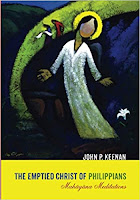The Emptied Christ of Philippians, a review.
The caption of the forward to The Emptied Christ of Philippians, Mahayana Meditations by John P. Keenan clearly lays out
what this book is about, “Divine Self-emptying: A Buddhist Lens on Christian
Scripture and Doctrine.” In the preface Keenan tells us this is a study of
Paul’s letter to the Philippians using Mahayana Buddhism as his hermeneutic
guide “in lieu of the primarily Greek philosophies that shaped Christian
understanding in the past.” The Emptied Christ of Philippians is a deep
exegetical study of Paul’s letter seen through the eyes of Buddhist philosophy.
Keenan compares the Orthodox teaching of kenosis with the
Buddhist teaching of sunyata. Kenosis is about Christ becoming flesh in the
personhood of Jesus. Orthodox teaching deals with the attributes of God, the
dual nature of Christ, and The Trinity. In Mahayana Buddhism, sunyata refers to
the tenet that "all things are empty of intrinsic existence and nature.”
Keenan’s work is an in-depth study of Philippians. It is
well researched and thought out. I read the book sitting at my desk with the
Bible on one side, and my phone on the other to look up references, quotes, and
articles. The work is not just academic, however. As the title suggests, it is
a mediation of the scripture as well. Keenan’s work challenges us to look at
Christ and Paul in new ways. Keenan writes, “Indeed, truth may even be an
obstacle awakening, for we tend to cling with idolatrous tenacity to our
enunciated truths.” By self-emptying and being in Christ, we engage in the
ongoing task to “reconfigure our very sense of self, not to be slavishly
codependent but to be re-formed.”
I chose to read this book because I am interested in the
intersection of Christian teaching with Buddhist and even Hindu teaching. I’ve
read Tantric Jesus and Living Buddha, Living Christ and thought
this book would be a good companion to those. Although it’s quite different in
style, I found it enlightening and educational. I would not recommend this for
light reading. This is an excellent study for clergy, preachers and for those
interested in going deeper into interfaith studies. This is a book you want to
keep on the shelf and go back to again and again.
Disclosure of Material Connection: I received this book
free from the author and/or publisher through the Speakeasy blogging book
review network. I was not required to write a positive review. The opinions I
have expressed are my own. I am disclosing this in accordance with the Federal
Trade Commission’s 16 CFR,Part 255.




Comments
Post a Comment